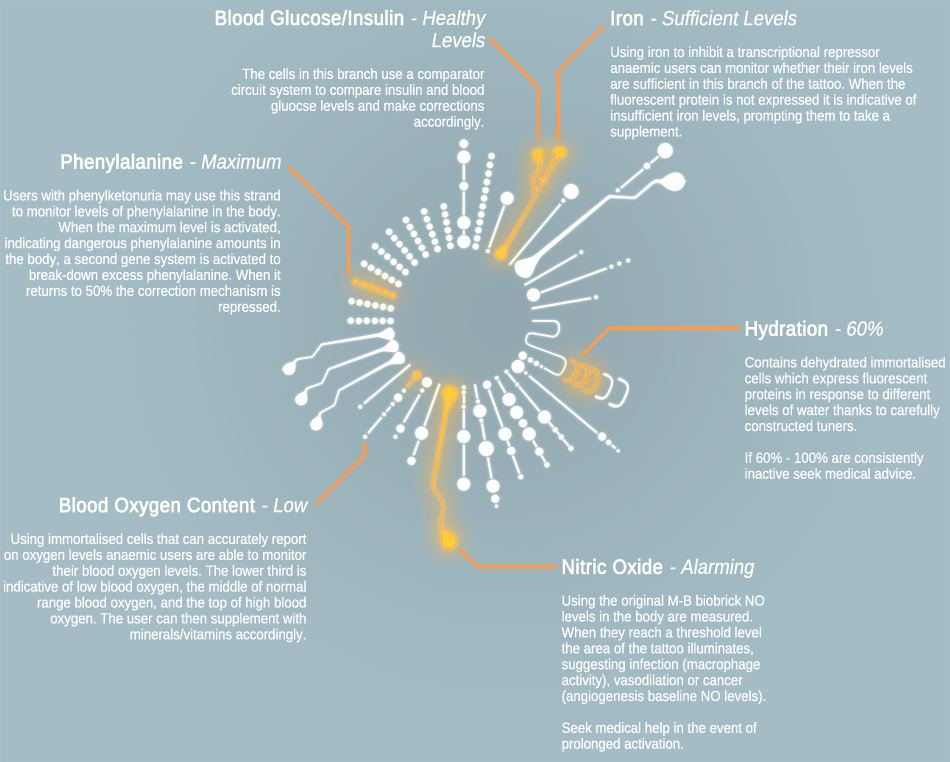Team:NRP-UEA-Norwich/Quanticare
From 2012.igem.org
(→Quanticare) |
|||
| Line 15: | Line 15: | ||
The comparator circuit project involves multiple promoters that are sensitive to similar chemicals, a different reporter/effector enzyme for each promoter, and a range of specially designed DNA leaders that go between the promoter and reporter of each gene system. The idea involves the specially designed DNA leaders being complementary to one another and resulting in DNA annealing which covers the ribosome binding site; this means that mRNAs transcribed following activation of the promoters will cancel one another out and fail to be translated. If there is an imbalance of substrates one set of mRNAs would be produced in excess of the others and would not anneal to one another, therefore resulting in translation and expression of the associated protein. This is demonstrated in ''Figure 1.'' where two sets of mRNA have been produced, one with an RFP reporter and one with a CFP reporter; due to an imbalance in substrates four lots of the RFP-associated mRNA have been produced, while only two lots of the CFP-associated mRNAs have been produced. As the image shows the two CFP-associated mRNAs have annealed with two of the RFP-associated mRNAs, blocking the RBS and preventing translation, however due to the imbalance there are two RFP-associated mRNAs left to be translated and thus RFP would be expressed in this situation. | The comparator circuit project involves multiple promoters that are sensitive to similar chemicals, a different reporter/effector enzyme for each promoter, and a range of specially designed DNA leaders that go between the promoter and reporter of each gene system. The idea involves the specially designed DNA leaders being complementary to one another and resulting in DNA annealing which covers the ribosome binding site; this means that mRNAs transcribed following activation of the promoters will cancel one another out and fail to be translated. If there is an imbalance of substrates one set of mRNAs would be produced in excess of the others and would not anneal to one another, therefore resulting in translation and expression of the associated protein. This is demonstrated in ''Figure 1.'' where two sets of mRNA have been produced, one with an RFP reporter and one with a CFP reporter; due to an imbalance in substrates four lots of the RFP-associated mRNA have been produced, while only two lots of the CFP-associated mRNAs have been produced. As the image shows the two CFP-associated mRNAs have annealed with two of the RFP-associated mRNAs, blocking the RBS and preventing translation, however due to the imbalance there are two RFP-associated mRNAs left to be translated and thus RFP would be expressed in this situation. | ||
| + | |||
| + | |||
| + | Similar comparator circuit set-ups would be used in the ''Cura'' tattoo. For instance in the case of Type I Diabetes one promoter would sense blood sugar while another would sense insulin; if the blood sugar outweighed the insulin, more of the mRNA with the blood sugar promoter would be produced and thus an effector enzyme for the production of insulin could be included in this mRNA in order to increase insulin production. If insulin production becomes too high the imbalance would shift so more of the mRNA with the insulin-sensing promoter was produced, and an effector enzyme to break down excess insulin could be translated from this mRNA strand in order to normalise insulin levels. A system such as this, as well as others, are explored in Figure 2. | ||
[[File:NRPCura.png | center | 950 px | thumbnail | '''Figure 2.''' ''Cura'' is Quanticare's revolutionary healthcare solution, a tattoo made of immortalised mammalian cells containing different biobricks that have been specifically tailored to monitor and respond to changes in the body. Different areas of the tattoo correspond to different areas of the body, and using biological technology developed by the Norwich Research Park and University of East Anglia 2012 iGEM Team can react automatically to many unwanted changes, as well as fluorescing to alert the user of any problems.]] | [[File:NRPCura.png | center | 950 px | thumbnail | '''Figure 2.''' ''Cura'' is Quanticare's revolutionary healthcare solution, a tattoo made of immortalised mammalian cells containing different biobricks that have been specifically tailored to monitor and respond to changes in the body. Different areas of the tattoo correspond to different areas of the body, and using biological technology developed by the Norwich Research Park and University of East Anglia 2012 iGEM Team can react automatically to many unwanted changes, as well as fluorescing to alert the user of any problems.]] | ||
Revision as of 14:04, 26 September 2012
 "
"


